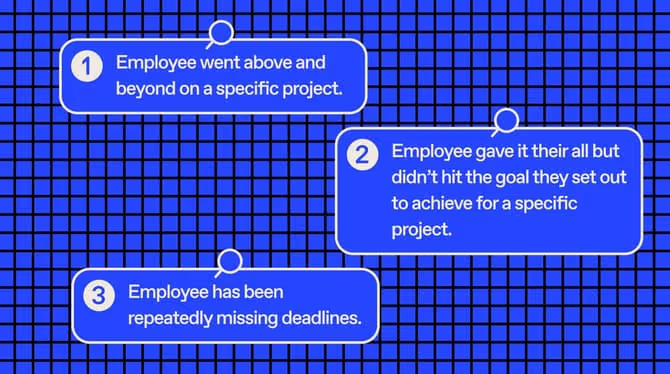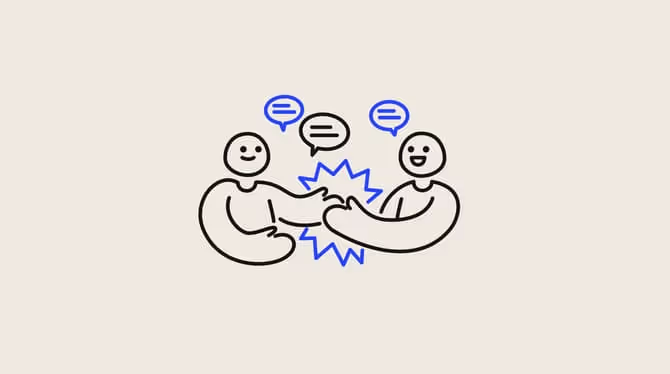26 constructive feedback examples and tips for managers

%20(1).png)
Constructive feedback is an essential tool in any manager’s arsenal to improve team performance and morale. Delivering constructive feedback requires empathetic communication skills, a people-centered mindset, and a good grasp of feedback methodologies.
Even the best leaders can sometimes find the constructive feedback process challenging. An effective way to learn and hone in on delivering helpful feedback is by taking a cue from a variety of different constructive feedback examples applied to different scenarios. So, we’ve rounded up 26 of them to help you master the art of giving constructive feedback!
What is constructive feedback: Meaning and team impact
The path to professional growth starts with providing constructive feedback, so understanding its importance as a cornerstone of progress and development is a great place to start.
Before we jump into our constructive feedback examples, this article first focuses on understanding the basics — including the process of giving feedback, the importance of empathy and active listening, and the impact constructive feedback has on employees.
Why constructive feedback matters
Constructive feedback matters because it acts as a catalyst for growth and improvement. It provides individual employees and teams the insights needed to help their own professional advancement — be it to achieve their targets, enhance their skills, or develop their relationships at work. When delivered effectively, constructive feedback helps employees understand their performance and keeps them accountable for their success.
By putting time and care into feedback, managers also demonstrate that they’re invested in supporting their teams, which, ultimately, creates a culture of trust and empowerment.
The benefits of constructive feedback
Only good things can come from constructive feedback. When delivered properly and regularly, it can result in increased motivation, productivity, and employee satisfaction. As an added bonus, constructive feedback can also build stronger relationships within a team, which boosts collaboration and collective performance.
{highlight}
The short and sweet: Simply put, the goal of constructive feedback is to point out areas of improvement in a way that is both helpful and positive, rather than critical. When done right, it's a powerful tool for promoting personal growth and enhancing employee performance.
{highlight}
Characteristics of constructive feedback
Effective feedback is specific, clear, and focused on behavior rather than on a person. Managers should deliver it in a timely fashion, while the memory of the action or behavior is still fresh and top of mind for the employee. And lastly, there should be a fair balance between positive reinforcement and points of improvement.
Specificity
Why does being specific matter when giving feedback? Because it allows employees to understand precisely which behaviors or actions they need to work on. This avoids guesswork, ensuring the issue isn’t misinterpreted and the road toward a solution is clear!
{highlight}
For example, “You’re always late” isn’t specific or objective enough. Instead, try “You’ve been late to the last three meetings.”
{highlight}
Clarity
Clarity in feedback explains the “why.” To ensure mutual understanding, managers should explain why a certain matter needs attention. This helps connect the dots. Providing examples to illustrate the point can help make the picture crystal clear
{highlight}
For example, a statement like “The meeting had to start later which caused issues” leaves the problem up to interpretation. Instead, give more context to the problem: “Because you arrived late to the meeting, it had to start later. That prevented us from having enough time to discuss X topic, which we needed to do.”
{highlight}
Objective
Constructive feedback needs to be objective. This is achieved by focusing feedback on observed behaviors and not personal characteristics. Addressing specific behaviors helps managers provide actionable insights and keeps the vibes non-judgmental.
{highlight}
A comment like “You don’t care about arriving on time!” is subjective, unhelpful, and likely untrue. Keeping feedback on behavior, such as “I noticed you’ve been 15 minutes late to most meetings in the last few weeks” removes judgment and sets things up for finding solutions.
{highlight}
Actionable
Lastly, feedback becomes constructive when the direction is solution-oriented and forward-looking. Managers should ask themselves: Does the feedback frame the next steps? By providing actionable feedback, employees have a map for improvement.
{highlight}
In the context where an employee has an issue with arriving to meetings on time, actionable feedback looks like: “Let’s make sure you can manage your time better. Can you share the day planning techniques you’re currently using and try a tool to help you?”
{highlight}
Delivering constructive feedback
There is, of course, an art to giving constructive feedback to ensure that it's well received. Start by stating what was done well, then follow this by pointing out the areas where improvement is needed. It's also important to offer specific suggestions or actions for how the situation can be improved so that the person has the tools they need to grow and progress positively and productively.
Some additional tips to deliver great feedback:
Choose the right time and place
Sometimes, timing is everything. By picking an appropriate moment and setting to provide them feedback, an employee will likely be more receptive. Delivering feedback during a five-minute window between meetings in a room with other people not only prevents the chance to ask questions and advice but could also risk embarrassing them. Make sure there’s enough time available for a discussion and create a moment with privacy.
Use the “feedback sandwich” method
The good ol’ sandwich method is about “sandwiching” constructive criticism between two positives. This sets the tone of the conversation, using praise to soften the delivery of the feedback. It also allows managers to end the conversation on an encouraging note, which helps mitigate defensiveness from the receiver.
An example of constructive feedback using the sandwich method looks like this: “I love how confident you are about sharing your ideas at our meetings. Because everyone needs to have a chance to speak, let’s work on how we can help you share the floor more. You’re a great speaker and I see how you could help inspire others to share ideas!”
Encourage two-way communication
While managers may be the ones providing constructive feedback, it’s important to remember that the feedback process should always be a two-way flow of communication. To reach a successful outcome, a little active listening can go a long way — keeping the conversation open, honest, and supportive.
The importance of empathy
There's a lot to be said about the way in which constructive feedback is given. When managers take an empathetic approach, it can make the feedback process even more effective. Considering the feelings of the person receiving the feedback, and putting yourself in their shoes, makes it easier to connect with them in a way that resonates and makes them feel more comfortable.
Receiving constructive feedback
Just like there’s an art to delivering feedback, there’s an art to receiving it too. Receiving feedback is the other side of the coin. It requires open-mindedness and willingness to learn and grow. It involves active listening, reflection, and a willingness to improve. Remember these principles:
Maintain an open mind
Being on the receiving end of constructive feedback, it’s essential to approach the process with an open mind. This is what fosters a growth mindset. After all, no one is perfect. It’s important to check one’s ego at the door, remain receptive rather than defensive, and remember that feedback is an opportunity to learn and improve.
Ask clarifying questions
Asking questions is part of active listening. The more questions asked, the more clarity and understanding one can have about the feedback one receives. This is why picking the right time and place is so important — there has to be room for constructive dialogue, so the receiver can walk away confidently, knowing exactly what they need to do because they had the opportunity to ask questions.
Develop an action plan
As with any constructive conversation, there should be clear next steps toward the solution. Based on the insights gained from feedback, an action plan with clear goals, strategies, and a timeline should be agreed upon between the manager and the employee. Action plans can also be adjusted and evolve, depending on the context. This is central to the continuous improvement philosophy.
The secret to effective feedback? Make it regular
Growth is perpetual and so should be constructive feedback. Make it a regular occurrence, rather than a one-off, to see ongoing improvement and prevent small issues from snowballing into larger ones. Regular check-ins help keep everyone aligned and on the right path to success.
Giving constructive feedback: Examples and scenario-based tips
Feedback is not just for quarterly performance reviews anymore and the ability to communicate effectively with employees is more critical than ever. Below, find 26 examples of constructive feedback for managers, with actionable advice to apply to your own real-life scenarios.
Improvement feedback examples for time management
Is an employee frequently late to team meetings or running behind in the morning? When discussing the issue, managers should show genuine concern, set clear expectations of their timeliness, and avoid an accusatory tone.
1. “I’ve noticed that you’re struggling to make it on time to your afternoon sessions with the team and I’m concerned that you may miss some vital information. Can we work together to develop a plan to make sure that this doesn’t happen again?”
2. “We’ve missed you during our morning team meetings. I know you have a heavy workload, but we value your input and ideas. How can I support you in improving your time management skills?”
Feedback with performance improvement recommendations
If an employee’s performance is declining, there's likely a logical explanation behind it with easy solutions. To avoid sounding accusatory, nosy, or invasive, managers should take a more generalist approach to the issue and open the conversation with a question.
3. “The team has noticed that you’ve missed some deadlines lately. Is everything ok? Let’s schedule some time to chat where we can assess your current workload and any roadblocks, and develop a plan so that you can get back to feeling focused and productive in your day-to-day.”
4. “I wanted to connect with you and see how you’re doing. I’ve noticed that you don’t show the same motivation as usual. How can I help you get back on track? Let’s review your priorities and brainstorm the best ways to accomplish them.”
{emphasize}
Follow our simple guidelines to address an employee's poor performance with confidence and put them back on the road to success.
{emphasize}
Improvement feedback examples for employee attitudes and team morale
Even one team member with a negative attitude can significantly affect employee morale. Constructive feedback can stop this issue in its tracks and shift the mood before it becomes too disruptive to the team.
5. “The team has recently noticed that you’re struggling to stay positive. We’re all in this together. Is there anything the team or I can do to help?”
6. “Hey, I wanted to check how you’ve been feeling lately. Can we talk about what’s bothering you? I appreciate how hard you’ve been working and I would like to help you overcome your challenges and lift your spirits. We can talk privately or schedule a team meeting for an open and honest discussion.”
{emphasize}
When negative attitudes enter the workplace, it can be tough on everyone. Learn more about how to give feedback on negative attitudes in the workplace.
{emphasize}
Constructive criticism examples for continuous improvement
Mistakes happen. But when they don’t get addressed, they are often repeated. When mistakes happen, managers should take a moment to course-correct to avoid mistakes becoming habits, and for employees to get the quality of their work back up to par.
7. “You’re generally very good at learning from past mistakes, but the team has noticed you making this one similar mistake during the current project. Understandably, such small things may slip through the cracks, but I wanted to flag it so that you can be more vigilant in the future.”
8. “You're usually someone who's eager to learn and grow. We've noticed that you've been a little less engaged lately. Is there something we can do to help you find your groove again?”
{highlight}
Pro tip: One-on-one meetings offer an excellent opportunity to bring up these kinds of conversations. During one-on-one sessions, empathize with employees to build a positive, judgment-free zone. Give concise, clear guidance and maintain an understanding but firm attitude.
{highlight}
Examples of constructive feedback for teamwork enhancement
Evaluating a team’s collaboration skills should be a top priority for leaders. Managers should address gaps in teamwork abilities by focusing on creating a mutually supportive environment and improving employee morale.
9. “You’ve got the talent and drive to be a shining star in this company, but you tend to stay apart from the wider team. What do you think would help you integrate better with your teammates?”
10. “I know you’re all hard workers and dedicated to your jobs, but we need to focus on improving collaboration and strengthening our group bond. Can we brainstorm solutions for making everyone feel like a valuable team player?”
{highlight}
Are your remote employees struggling to collaborate? Here are some tips to increase collaboration and foster better relationships across your remote team.
{highlight}
Constructive feedback to improve communication style and skills
Effective communication between managers and employees is a critical component of success. Providing regular, constructive feedback is vital for improving communication in a group setting and during one-on-one meetings.
11. “I’ve noticed that we sometimes have a communication mismatch. Do you want to work together to better understand how we can communicate more effectively?”
12. “Your work has been great, but I've noticed that you've been a bit quieter lately. Can we schedule a weekly sync so I can stay in the loop and offer my support when you need it?”
{highlight}
Pro tip: When it comes to delivering constructive feedback, keep your communication clear, objective, authentic, and fact-based. Ask for feedback during your next one-on-one to understand how your team member feels about your communication skills and how you can improve.
{highlight}
Constructive feedback to improve listening skills in group discussions
If team members operate in a fast-paced environment, sometimes the extroverts will unknowingly “take over” in a group meeting while others get lost in the shuffle. While there is nothing wrong with having passionate employees, talking over others isn’t conducive to productivity or collaboration. Managers should find constructive ways to even the playing field.
13. “I appreciate the passion you bring to the project! However, you also need to make space for others to be included in the conversation. Letting others speak will support your development, and it will also help other members of the team bring creative ideas. Let’s come up with a solution that channels your passion and that of the team.”
14. “I love the creativity and new ideas you bring to our brainstorming sessions. But, when you get excited, sometimes you forget to share the floor. When I’m in a creative flow, I write down my ideas while others speak so I can remember them. Would you like to try that during our next group collaboration?”
Goal-oriented feedback to support target achievement
Employees with a solid commitment to their jobs will have moments when they feel disappointed and guilty about missing a goal. Managers should acknowledge their disappointment and lift them back up by giving feedback that offers actionable solutions to prevent the same missed opportunities in the future.
15. “We appreciate your passion for this project, even if you didn't hit the goal you set out to achieve. What can we learn from this experience? I’m always here to support you if you need help meeting your next goal.”
16. “Your work ethic and dedication to achieving goals are admirable and a valuable part of this team. I know you’re upset that [project name] didn’t go exactly as planned, but it’s a meaningful learning experience. How can we realign your goals moving forward to ensure success?”
{highlight}
Browse through our employee goal-setting examples and learn how to set measurable and attainable goals that will make your employees shine.
{highlight}
Feedback to encourage camaraderie and interpersonal relationships
When teammates get along, the positive vibes are infectious. People who genuinely like each other produce extraordinary teamwork. Managers can expect to see greater creativity, stronger bonds, and better morale when they encourage positive social interactions.
17. “I've noticed that you haven't been getting along as well with [employee name] lately, and I’ve also noticed that many team members have been in the same boat. Shall we get together and set the record straight about what's causing the disconnect?”
18. “Hey, I noticed the tension between you and [employee name]. You’re valuable team members, and I want to help you work through your issues together. Can I schedule a mediation session to help you both understand each other better?”
{highlight}
💌 Encourage your employees to recognize each other. A platform like Good Vibes makes peer-to-peer recognition fun and easy and contributes to creating a positive culture and strong team relationships.
{highlight}
Feedback to encourage taking initiative and autonomy
Every successful manager pushes employees to take the initiative when problem-solving. It facilitates productivity and development on the team. It’s important to encourage independence but also be clear that any employee who feels stuck can reach out for help.
19. “I’m glad that you’re comfortable asking for help. That’s an important skill. Next time you need a hand, I would like to see you bring forth possible solutions you've come up with, along with your request.”
20. “I appreciate all your hard work on [project name], but I noticed you needed extra help. I know you’re a resourceful person. What kind of help can I give you to help you improve your confidence in your critical thinking and problem-solving skills?”
Constructive feedback to help facilitate feedback reception
For constructive feedback to be both understood and effective, it needs to be clear, concise, and contain actionable guidance. Managers can set their team up for success by outlining clear expectations and boundaries regarding workload, and offer the space to open up conversations around the feedback.
21. “I know performance reviews can be challenging to hear and you may not agree with all of the constructive criticism you’ve received. If there’s anything you want to discuss further, please feel free to reach out.”
22. “I’d like to schedule a weekly one-on-one meeting together. Let’s use this time to make sure we’re clear about expectations and priorities. You’re a great team member, and I want to help you succeed.”
Feedback offering conflict resolution strategies
When working with humans, interpersonal conflict is inevitable. That said, it needs to be resolved fast. By intervening and offering guidance on conflict resolution techniques, managers can help mediate tensions between co-workers and maintain a positive working atmosphere for everyone at work!
23. “I’ve noticed tension rise between you and your peer during the meeting. Unresolved conflict could affect our team’s productivity. Let’s schedule a private moment to discuss the issue openly and find solutions that work for the both of you.”
24. “It seems like there’s a misunderstanding about the recent project allocations. Let’s have a team meeting to clarify roles, responsibilities, and expectations so that everyone can feel confident in what they need to focus on.”
Feedback to recognize effort and initiative
Just like it’s important to flag areas to improve, it’s crucial to also highlight what’s going well. Positive feedback is incredibly powerful — a means to boost confidence and reinforce behaviors they want to keep seeing. Managers should use that tactic to their advantage!
25. “I want to commend you for your initiative in spearheading last Friday’s presentation. You took the lead and delivered the numbers confidently. It made a big impression on everyone — great job!”
26. “Thanks for jumping in on that project yesterday. Your proactiveness and team player attitude showed through. Keep that up!”
{highlight}
Hungry for more? Take a look at these 24 employee feedback examples to help you discuss recognition, areas of improvement, goal setting, and more.
{highlight}
When to use different types of constructive feedback
Different circumstances require different solutions and knowing what type of feedback to give in a particular situation is an invaluable management skill. Here, we look at two types of constructive feedback: feedback to reinforce good behaviors and feedback to improve less-than-great behaviors.
Use positive feedback to reinforce strengths and celebrate success
When a team member does well, giving positive employee feedback celebrates their success and reinforces positive actions and behaviors. By recognizing an employee’s positive impact, managers provide them with a clear understanding of their work’s value to the team.
Use constructive criticism to target areas of growth and development
There's a difference between negative feedback and constructive feedback. Negative feedback focuses on negative attributes and can be perceived badly, whereas constructive feedback (or constructive criticism) focuses on the positive possibility and guides the recipient toward a better outcome. By providing solutions to issues, managers are ensuring their feedback is constructive and helpful, rather than just pointing out the issues and making the employee feel demoralized.
Remember, great feedback doesn't always need to be purely positive. Constructive feedback can include praise, criticism, or both — as long as it’s fact-based (not opinion-based) and sets the employee up for a chance to improve, grow, and succeed.
{highlight}
Check out our comprehensive guide to employee feedback to learn everything you need to know about this critical managerial skill.
{highlight}
Challenges in giving and receiving constructive feedback
Understanding the benefits of continuous feedback is the first step toward fostering a healthier workplace, but the practicalities of integrating feedback into a corporate culture can be a challenge. Some people struggle with effectively communicating feedback without causing offense or demotivation, while others find it challenging to receive feedback without feeling defensive or demotivated.
A whole lot can be going on that impacts a productive feedback loop. If you’re struggling with maintaining a positive feedback culture, the following realities might be at play:
- Fear of offending the receiver and causing conflict
- Taking feedback personally due to projection
- Cultural differences that influence communication style
- Power dynamics affecting feedback exchange
- Past experiences with negative feedback
- Lack of clarity or balance in positive and negative feedback
- Picking the wrong time where the conversation is rushed
- Not creating a safe environment for honest dialogue
- Difficulty with managing emotions and self-regulation
Overcoming feedback challenges is part of the commitment to create a culture of open communication and continuous improvement.
How to build a feedback-oriented workplace culture
Just like Rome wasn’t built in one day, an office culture is built collectively — one action at a time. So how can managers start nurturing a strong feedback culture? With effective communication and using feedback tools to their advantage!
Clear communication tips: Make feedback specific and actionable
One of the keys to effective feedback is making sure it’s specific and actionable. Vague or general comments don’t allow the receiver to have a clear understanding of which behaviors need to be targeted and addressed.
So what does clear, specific, and actionable feedback look like?
“I noticed your late attendance lately, such as with [X, Y, and Z instances]. Everyone needs to show up to meetings on time so we can all make the most out of them and be as productive as possible. If we can get a plan in place to help you, like blocking out 10 min before every meeting so you have wiggle room, I’d like to start seeing improvement starting next week. How does that sound?”
By offering specific examples of what needs to be improved, suggestions for improvement, and expected outcomes, the receiver can see a clear path forward.
{highlight}
Future framing: When delivering feedback try focusing on the future instead of dwelling on past mistakes. What’s done is done, and it’s important to maintain a positive outlook on what can be fixed and what’s ahead. This framing ensures the feedback is constructive — not criticizing.
{highlight}
Constructive feedback tools and techniques for managers
People may be reluctant to provide feedback to their superiors out of fear of repercussions or the belief that their input will remain unheard. It’s crucial to encourage communication without repercussions, both from employees and managers.
Anonymous surveys are an excellent place to start. They can show employees that the company is ready to listen while also allowing managers to identify systemic issues in the organization.
One useful tip is to customize surveys. By asking employees specific or open-ended questions, managers might get more valuable and actionable feedback than generic questions with a scaling system. Personalized questions give employees a safe space to share their honest thoughts and spark conversations that probably wouldn’t happen otherwise.
{emphasize}
Gain your team’s confidence with Officevibe’s employee feedback tool: a conversation starter with examples of constructive feedback for employees to provide their own insights and perspectives. This tool enables managers to gather honest thoughts through surveys, follow-up questions, and a free feedback section — all with the option for anonymity.
{emphasize}
Constructive feedback: A boost to everyone’s performance
Clearly, constructive feedback is the key to enhancing a team’s overall performance, improving morale, and even strengthening relationships in the workplace. Sure, having these types of conversations may feel awkward or unnatural at first, but the constructive feedback examples listed in this article are a great place to start.
Give HR and managers the clarity, confidence, and connection to lead better every day.


%20(1).avif)


.avif)
.avif)





.avif)


